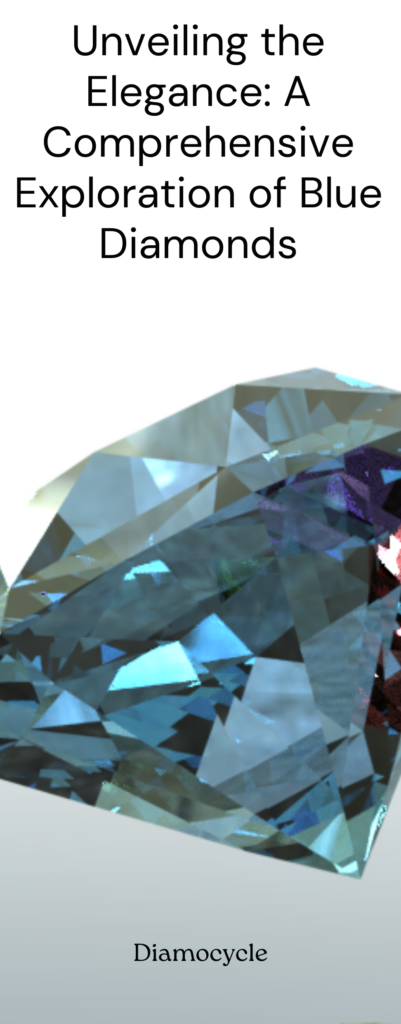In the enchanting world of fine jewelry, where elegance meets rarity, blue diamonds emerge as celestial wonders that captivate the heart and soul. Diamocycle, with a legacy steeped in the appreciation of rare gemstones dating back to 1857, invites you on a journey into the depths of blue diamonds. Beyond their breathtaking hues lies a world of mystery, rarity, and geological marvels that add an extra layer of allure to these exceptional gems.
1. Are Blue Diamonds Real?
Blue diamonds are not just figments of imagination; they are genuine and exceptionally rare. Their uniqueness lies in the presence of boron during their formation, a distinctive factor that transforms them into captivating jewels. The chemical dance that happens deep within the Earth gives these diamonds a uniqueness that Diamocycle cherishes, ensuring that every blue diamond in our collection is an authentic masterpiece.
2. What is a Natural Blue Diamond?
A natural blue diamond is not merely a gem; it’s a testament to the marvels of nature. Born deep within the Earth’s mantle, these diamonds bear the mark of boron, an element rarely found in their crystalline siblings. This geological masterpiece involves a symphony of factors: extreme pressure, soaring temperatures, and the slow crystallization process that shapes these diamonds over millions of years.
3. How Rare are Blue Diamonds?
Blue diamonds proudly wear the crown of rarity, standing as one of the scarcest diamonds globally. They constitute a minute fraction of all diamonds mined worldwide, and their scarcity elevates their allure, making them coveted treasures for those who seek the extraordinary. In fact, they are so rare that out of every 10,000 carats of diamonds mined, only a single carat might be a blue diamond.
4. How Blue Diamonds are Made?
The alchemy of blue diamonds lies in their unique chemical composition. Born with the infusion of boron during their formation, blue diamonds emerge as exceptional gemstones. This geological alchemy involves the incorporation of boron atoms into the diamond’s crystal lattice structure, resulting in the captivating blue color that distinguishes these gems from their colorless counterparts.
5. How are Blue Diamonds Formed?
Blue diamonds, sculpted in the depths of the Earth, embark on a journey that involves intense pressure, soaring temperatures, and the drama of volcanic eruptions. Their ascent from the depths to the surface is a geological ballet that unfolds over millions of years. The volcanic eruptions that bring them closer to the surface also play a crucial role in their discovery by miners.
6. Where do Blue Diamonds Come From?
The illustrious Cullinan Mine in South Africa takes center stage as a primary source of blue diamonds. This mine, with its rich history dating back over a century, has yielded some of the world’s most renowned diamonds, including the Cullinan Diamond, which was the largest rough gem-quality diamond ever found. Beyond South Africa, blue diamonds also emerge from mines in India, Australia, and the historically rich Golconda region.
7. The Price of Blue Diamonds
Blue diamonds, with their captivating blue hues, command prices that reflect their rarity and individual character. Categorized based on color intensity, from faint to fancy deep, the price of a blue diamond is a reflection of its uniqueness. The most valuable blue diamonds exhibit a deep, pure blue coloration. In 2014, a 13.22-carat blue diamond set a world record when it sold for over $23 million per carat.
8. Blue Diamonds vs Blue Sapphires: How to Tell the Difference
Distinguishing between blue diamonds and blue sapphires involves understanding their intrinsic qualities. As a purveyor of fine jewels, Diamocycle recognizes the importance of education. Blue diamonds, being diamonds, boast exceptional hardness, allowing enthusiasts to differentiate them from blue sapphires based on their durability and refractive indices. Blue diamonds also exhibit a unique phenomenon called phosphorescence, where they continue to glow after exposure to ultraviolet light, setting them apart from blue sapphires.
9. What Are The Prices of Blue Diamond Rings?
Blue diamond rings, adorned with these celestial gems, vary in price based on several factors. Carat weight, color intensity, clarity, and overall quality all contribute to the value of these treasures. Diamocycle, committed to transparency, showcases a range of blue diamond rings, offering options that cater to diverse tastes and preferences. In 2019, a 20.46-carat blue diamond ring sold for over $2 million at auction, highlighting the premium prices these exceptional jewels can achieve.
Conclusion:
As we unveil the elegance of blue diamonds, we recognize them not just as gemstones but as storytellers of Earth’s geological history. Blue diamonds, with their ethereal beauty and geological uniqueness, stand as rare treasures in the world of gemstones. As we delve into the depths of blue diamonds, their rarity, formation, and allure become not just facets of a gemstone but chapters in a captivating geological narrative. Each blue diamond tells a story that spans millions of years, and Diamocycle takes pride in being the curator of these extraordinary tales.

